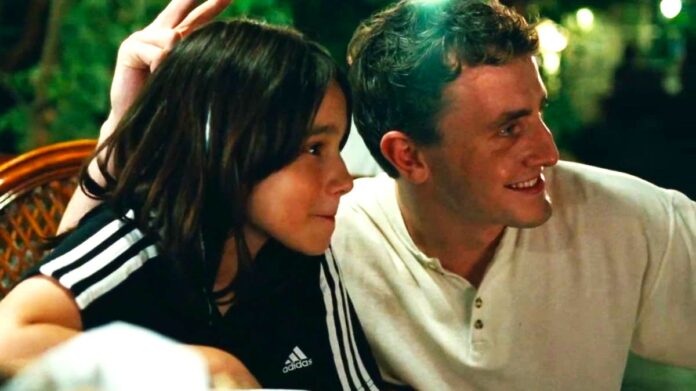Oftentimes, just because of the manner in which the language of cinema has developed over the years, our mind perceives it in a certain way. The ways of popular cinema have surrounded our minds so much that seldom is there a room to pause in between shots to reflect on the characters. Popular cinema is about an active flow of time and about change to some degree in emotions, which is sketched in its entirety in all of our minds; we all subscribe to the three-act structure without ever having read or known about it. “Aftersun” doesn’t believe in the mere flow of time but in the stretching of it that delves into the depths of the human condition to reveal those layers of emotions that would otherwise hide below the garb of a ‘structure.’ Charlotte Wells’ style resembles that of Kiarostami at times, lingering for longer durations than usual at certain shots. When speaking of this stretching of time by elongating the shots, Kiarostami mentions how by doing that, some time is given to the audience to fully consume the tonal shifts, which provides a very subtle release. Wells uses a similar sensibility in telling the story of a father and daughter while tenderly bringing together her compassionate array of shots that sing to the tunes of their melancholic aroma.
Taking place over a period of a few days at a resort, 11-year-old Sophie takes a summer holiday in Turkey with her father, Calum, to celebrate his 31st birthday. The story unfolds through video footage taken by both of them during that time. Calum is grappling with issues of his own, with scars from his own childhood and an unstable financial life that make things difficult for both of them. There are no visibly giant shifts in the narrative that make up for these conflicts. Wells uncovers instances slowly, and we come to discover the traumas of Calum through these silently devastating sequences. There is a striking use of editing, sometimes cutting between the video camera footage and a surreal sequence from a rave party where Calum and a much older Sophie interact with one another through dance. There are moments filled with utmost tenderness showing the intimate bond between the two, and then there are conflicting sequences of their interaction. Through just these minor incidents, we come to terms with the life of Calum, who is perhaps burdened with too many responsibilities at such an early age. People mistake him for Sophie’s brother, there is talk of his unstable job, and there are hints of a harrowing childhood. Sophie doesn’t understand a lot of these things during the vacation. The film feels autobiographical in the way it chooses to tell the story, with Sophie looking back at the vacation and trying to understand her father, just as perhaps Wells is too, through the film. Brief visuals of some other parents and their children are put in as well to join the thematic link about their relationship. It is done not to offer any comparison, but it is just there, flavoring everything together.
Wells is meditative in her study of the two. There are moments where the camera just floats like water going up and down; it stays on an action long after it has happened. Such moments allow us to delve deeper by creating an unusual mystery about its world. The Filmmaking here doesn’t work to capitalize on the power of the cut or a shot to bend our thinking in a particular way. Rather, it invites us to stay within its frames and work according to how Wells wants to. This is a very meticulous and disciplined way to present the story, where the aesthetics drive emotions more than the actual happenings. The film grows on you each minute till it reaches the climax, shattering you in pieces, and all of that is done only through the coordination of the cuts and visuals along with the performances of the two. There is a deeply contemplative music that plays in some vital scenes, which complements it, and some songs that provide the much-needed sensual release.
“Aftersun” is evocative filmmaking at its best; it can only be told through the medium of cinema, as the dimensions in which Wells goes are possible only because of the interplay of audio-visuals. A lot of footage from the video camera is repeated and unfolded separately in different instances, accentuating the resulting effect. The last 15 minutes sum up the entire film as it climaxes according to its own structure and style, depositing a cloudy feeling in our hearts and minds. It is cinema at its best, blossoming in its full form depending strongly on the nuances of the artform, never wanting to make a point but rather feeling like an all-pervading vessel that is heartbreakingly beautiful. If other films work on the principle of hitting the bullseye, “Aftersun” is more like arriving. Like waves in a perfectly still ocean surrounding the shore on a full moon night.

